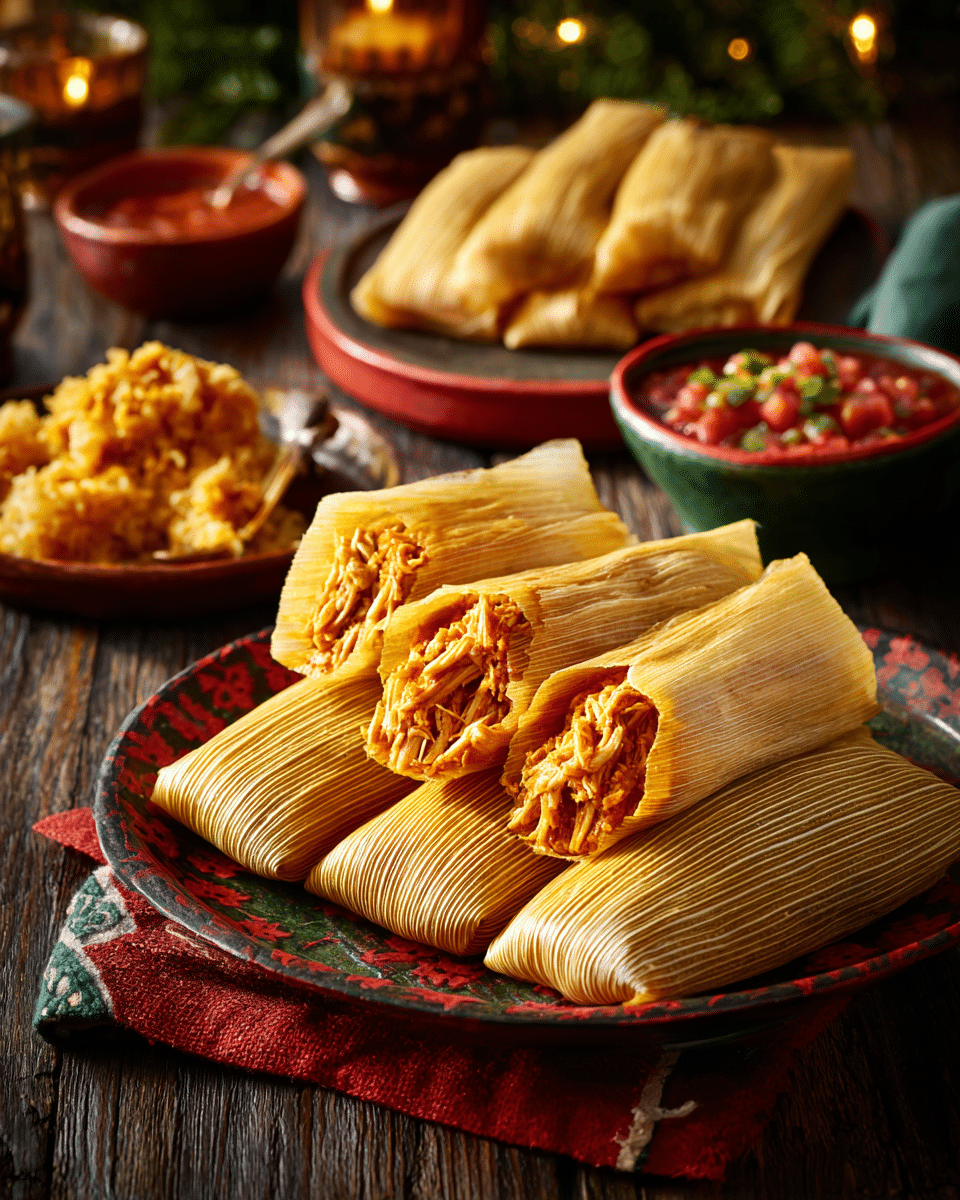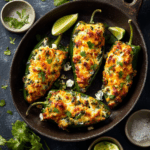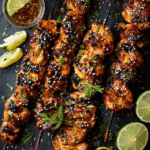Tamales are a traditional Latin American dish with deep cultural roots, especially prominent in Mexican cuisine. These hearty parcels consist of a flavorful masa dough filled with meats, cheeses, vegetables, or chilies, all wrapped in corn husks and steamed to perfection. Often prepared during festive occasions and family gatherings, tamales symbolize community, tradition, and celebration. The process may be labor-intensive, but the rich, comforting flavors and satisfying textures make tamales a beloved staple enjoyed worldwide.
FULL RECIPE
Ingredients
- 4 cups masa harina (corn flour for tamales)
- 2 1/2 cups chicken broth (or vegetable broth)
- 1 cup lard or vegetable shortening
- 2 teaspoons baking powder
- 2 teaspoons salt
- 3 cups cooked shredded chicken (or pork/beef)
- 2 cups red chili sauce (or salsa verde for variation)
- 30-40 dried corn husks, soaked in warm water for 30 minutes
Directions
- Soak dried corn husks in warm water for at least 30 minutes until pliable. Drain and pat dry.
- In a large mixing bowl, beat the lard or shortening until fluffy using a hand mixer or stand mixer.
- In a separate bowl, mix masa harina, baking powder, and salt. Gradually add the chicken broth to the dry ingredients and stir until combined.
- Slowly add the masa mixture to the whipped lard, mixing continuously until the dough is light and fluffy. A good test is that a small piece of dough floats in cold water.
- In another bowl, mix the shredded chicken with chili sauce until well coated.
- To assemble tamales, spread about 2 tablespoons of masa dough onto the center of a soaked corn husk, leaving space at the edges.
- Add a spoonful of the meat filling on top of the masa. Fold the sides of the husk in towards the center, then fold the bottom end up.
- Arrange tamales upright in a steamer basket with the open end facing up. Cover with a damp cloth and the remaining husks.
- Steam the tamales for about 1 to 1 1/2 hours, checking occasionally to add water to the steamer if needed. Tamales are done when the masa pulls away easily from the husk.
- Let tamales cool slightly before serving. Enjoy with extra salsa, crema, or guacamole.
Nutrition Facts
- Calories: 350
- Total Fat: 18g
- Saturated Fat: 6g
- Cholesterol: 65mg
- Sodium: 550mg
- Total Carbohydrates: 30g
- Dietary Fiber: 3g
- Sugars: 2g
- Protein: 18g
Historical and Cultural Significance of Tamales
Tamales have a rich history dating back thousands of years to ancient Mesoamerican civilizations such as the Aztecs and Mayans. Traditionally, tamales were made as portable meals for hunters and warriors, wrapped in corn husks to preserve and transport food easily. Over time, tamales evolved into a ceremonial and festive dish, deeply woven into cultural celebrations, religious holidays, and family gatherings throughout Latin America. The preparation of tamales often serves as a communal activity, where generations come together to share stories, recipes, and traditions, preserving cultural heritage through food.
Understanding the Masa Dough
The base of any tamale is the masa dough, made from masa harina, a special corn flour treated with lime (nixtamalization). This process enhances the nutritional profile of the corn and gives the dough its unique flavor and texture. Masa dough is soft, pliable, and slightly grainy, providing a sturdy but tender wrapper that steams to a perfect consistency. Achieving the right masa texture is crucial; it should be light enough to steam well but firm enough to hold the filling without breaking apart.
Popular Fillings and Flavor Profiles
Tamales come with a wide variety of fillings, reflecting regional and personal preferences. Common savory fillings include shredded chicken, pork, beef, or cheese combined with chili sauces such as red chile, green salsa, or mole. Vegetarian versions may feature beans, roasted vegetables, or cheese with peppers. Sweet tamales are also popular, made with ingredients like cinnamon, raisins, pineapple, or chocolate. Each filling imparts its own character, making tamales incredibly versatile and able to suit a range of tastes and occasions.
The Art of Wrapping and Steaming
Wrapping tamales in corn husks is an art form that requires practice to master. The husks not only hold the tamale together but also infuse subtle flavor during steaming. The dough and filling are carefully layered, and the husk is folded tightly to prevent leaking. Proper steaming is essential for cooking the tamales evenly, usually taking between one to two hours. The steam gently cooks the masa dough and filling, ensuring the tamale remains moist and tender. Oversteaming or insufficient steaming can negatively affect the texture, so timing and moisture control are key.
Health Benefits and Nutritional Aspects
Tamales provide a balanced meal with a combination of carbohydrates, protein, and fats. Masa, made from corn, offers dietary fiber and essential nutrients like niacin, which is increased through nixtamalization. When filled with lean meats or beans, tamales provide a good source of protein. However, traditional recipes often use lard, which adds saturated fat, so lighter versions can be made with vegetable shortening or oil for a healthier option. The versatility of tamales allows for adaptations that fit various dietary needs without sacrificing flavor.
Regional Variations Across Latin America
Tamales vary widely across Latin American countries, each offering unique twists based on local ingredients and culinary traditions. In Mexico, tamales are typically wrapped in corn husks and filled with meats and chilies. In Guatemala, tamales are larger and often wrapped in banana leaves, giving a distinct aroma and flavor. Venezuela and Colombia feature hallacas, a type of tamale with diverse fillings and wrapped in plantain leaves. These regional differences highlight the tamale’s cultural significance and adaptability, reflecting local tastes and histories.
Serving Suggestions and Pairings
Tamales are often served as a main course but can also be part of a larger feast. Common accompaniments include Mexican crema, salsa verde or roja, guacamole, and pickled jalapeños. A fresh side salad or rice and beans complement tamales well, balancing the hearty nature of the dish. For festive occasions, tamales might be paired with traditional drinks such as atole, champurrado, or horchata, enhancing the overall dining experience with complementary flavors and textures.
Storage and Reheating Tips
Leftover tamales store very well and can be refrigerated or frozen for later enjoyment. To keep them fresh, wrap tamales individually in plastic wrap or foil before placing them in an airtight container. When reheating, steaming is preferred to maintain moisture and texture, but microwaving covered with a damp paper towel also works for convenience. Proper storage and reheating ensure that tamales retain their original flavors and tenderness, making them a practical make-ahead meal.
Adapting Tamales for Special Diets
With its adaptable nature, tamales can be tailored to fit many dietary restrictions and preferences. Gluten-free by nature, tamales are a great option for those avoiding wheat or gluten. Vegetarian and vegan tamales can be made with fillings like beans, vegetables, and plant-based cheeses, and the lard in the dough can be replaced with vegetable shortening or oils. Low-fat or lower-sodium versions are achievable by selecting lean meats and controlling seasoning. These modifications allow more people to enjoy this traditional dish without compromising on taste.
Advertisement
Community and Family Traditions Around Tamales
Making tamales is often a family affair, involving multiple generations gathering to prepare, wrap, and steam dozens or even hundreds of tamales together. This communal cooking fosters bonding and helps pass down recipes and cultural knowledge. Celebrations such as Christmas, Día de los Muertos, and weddings frequently feature tamales as a centerpiece, underscoring their importance beyond just food. The shared experience of tamale-making brings people together, creating lasting memories and reinforcing cultural identity.
Conclusion
Tamales are much more than a comforting meal; they are a rich cultural tradition that embodies community, history, and culinary artistry. Their versatility, from savory to sweet, and their ability to adapt to various dietary needs make them a beloved dish across Latin America and beyond. Whether enjoyed at festive celebrations or simple family dinners, tamales offer a delicious way to connect with heritage while sharing warmth and hospitality.






